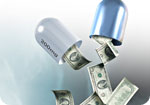
Harvard Psychiatrists Hide Millions of Dollars Received from Drug Companies
Friday, November 07, 2008 by: David Gutierrez, staff writer
Tags: psychiatrists, health news, Natural News
- Chemtrails unveiled: How the CIA and Big Business are manipulating the weather for profit
- Mysterious underwater pyramid off Japan could rewrite ancient history
- Israeli lobbyists boast of controlling US national security policy in leaked AIPAC audio
- How to live without electricity: A practical guide for survival and preparedness
- Tulsi Gabbard leads charge against the Biden regime’s global censorship of the 'Disinformation Dozen'
- Geoengineers forced into secrecy as public backlash grows: How climate elites are manipulating populations to accept geoengineering experiments
- Fauci is back in the limelight, and he’s busy promoting a future COVID or FLU pandemic
- Pfizer's RSV vaccine linked to preterm births as drug giant CONCEALED RISKS from pregnant women in unethical clinical trials
- Common household chemicals linked to America's depression epidemic
- Shedding light on the dark side of MMR vaccines: How vaccinated individuals SPREAD MEASLES & put the vulnerable at risk
- Analysis: The coming economic collapse, a mass uprising and Trump's three secret weapons to halt the growing revolt
- The HEART-HEALING power of SEVEN Mediterranean plants
- Over 30 pieces of evidence on how ‘the climate scam is collapsing’
- Aerosolized bioweapons? Strange “diploid biomasses” falling out of the sky in Florida captured under the microscope
- Widespread social and economic unrest: Steve Quayle issues urgent financial warning of imminent asset collapse in new interview with Mike Adams
- Tulsi Gabbard takes aim at censorship: Justice for the ‘Disinformation Dozen’
- Mike Adams releases country western hit single: Goin’ Back in Time is Comin’ Home
- U.S. lawmakers investigate Meta over alleged China collaboration
- Aerosolized bioweapons? Strange “diploid biomasses” falling out of the sky in Florida captured under the microscope
- Widespread social and economic unrest: Steve Quayle issues urgent financial warning of imminent asset collapse in new interview with Mike Adams
- CLOT SHOT PLANDEMIC UNFOLDING: Fibrous, rubbery clots caused by covid injections have prion-like seeding activity
- Analysis: The coming economic collapse, a mass uprising and Trump's three secret weapons to halt the growing revolt
- Kiss Your Genetic Privacy Good-Bye! 23andMe Gets Green Light to Sell Your Intimate Genetic Details to Anyone They Want
- Tulsi Gabbard leads charge against the Biden regime’s global censorship of the 'Disinformation Dozen'
- Mike Adams releases country western hit single: Goin’ Back in Time is Comin’ Home
- DEATH by VACCINE or face PRISON time: Canadian Freedom Convoy leaders CONVICTED for protesting forced vaccination during the Covid Plandemic
- Fauci is back in the limelight, and he’s busy promoting a future COVID or FLU pandemic
- How Israeli military-connected corporations are secretly controlling your online privacy
- European Court of Justice: Healthcare professionals who promoted or administered COVID-19 vaccines are CRIMINALLY LIABLE for any harm caused
- Defunding DEADLY mRNA jabs: Government funding for mRNA technology being scrutinized and sidelined until proven "safe and effective" for real
- Tulsi Gabbard takes aim at censorship: Justice for the ‘Disinformation Dozen’
- Federal employees whine over DOGE's new directive requiring them to do a 5-point summary of weekly accomplishments
- U.S. approves new Russian ambassador as diplomatic thaw continues
- I Want My Bailout Money – new song and music video released by Mike Adams
- Trump administration poised to overhaul crypto regulations with new SEC leadership
- I Want My Bailout Money – new song released by Mike Adams
- Newly released JFK files reveal Pentagon's role in creating Lyme disease and covid in the same lab
- Mike Adams releases country western hit single: Goin’ Back in Time is Comin’ Home
- Analysis: The coming economic collapse, a mass uprising and Trump's three secret weapons to halt the growing revolt
- MEDICAL BOMBSHELL: FDA admits Covid mRNA 'Vaccines' CAUSE CANCER
- Dr. Mike Yeadon releases 15-minute testimony - WATCH - about genocidal intent of COVID “vaccines”
- Trump reverses course on Gaza plan, says “nobody is expelling Palestinians”
- 5 Simple steps to boost your brainpower: How to strengthen executive function in a distracted world
- The Health Ranger releases “Vaccine Zombie” song and music video, using AI-animated zombies for the music video
- California's social media censorship law struck down: A victory for free speech or a threat to online safety?
- Rep. Nancy Mace introduces bill to ban biological males from female facilities on federal property
- EPA advisor admits the agency is funneling billions to climate groups ahead of Trump’s return to White House
- Survival 101: Effective EMF blocking techniques
- Aerosolized bioweapons? Strange “diploid biomasses” falling out of the sky in Florida captured under the microscope
- OpenAI whistleblower who dissented against how the company trained ChatGPT found dead
- Trump Administration cuts 2,000 USAID jobs, places most employees on leave in sweeping reform effort
- A lack of integrity in Academia: Harvard professor found GUILTY of fraudulent research to promote CRT theory
- Sugarcane extract superior to cholesterol-lowering drugs?
- RFK Jr.'s SSRI antidepressant investigation sparks liberal meltdown, exposes Big Pharma's dangerous game
- Red Cross issues warning to stop blood plasma donations from vaccinated people
- Scientists confirm: GENIUS brain function can be spontaneously unleashed in humans without any apparent cause
- EPA advisor admits the agency is funneling billions to climate groups ahead of Trump’s return to White House
- HYSSOP: What research reveals about the health benefits of this ancient holy herb
- Two containers with completed ballots fall out of truck in Florida
- Fully vaccinated about to see “tsunami” of illness and death, warns virologist
- Global leaders unite to clamp down on “misinformation” with UN-backed Cascais Declaration
- Newly released JFK files reveal Pentagon's role in creating Lyme disease and covid in the same lab
- BREAKING: 2025 NDAA authorizes mandatory military draft of WOMEN across America… as Pentagon pursues global NUCLEAR war with both Russia and China at the same time
- Michael Yon warns of a ZIONIST TAKEOVER in Trump’s second administration
- Ozempic and Wegovy weight loss drugs are injectable LIZARD VENOM PEPTIDES that may unleash a devastating wave of organ failure… side effects align with symptoms of SNAKE BITES
- The Health Ranger releases “Vaccine Zombie” song and music video, using AI-animated zombies for the music video
- BOMBSHELL: DNA testing kits are a SCAM to develop ethnic-specific bioweapons
- Israeli soldiers accused of even more torture and abuse in the West Bank
- These 13 countries just signed an agreement to engineer a global FAMINE by destroying food supply
- Mike Adams releases country western hit single: Goin’ Back in Time is Comin’ Home
- NASA admits that climate change occurs because of changes in Earth’s solar orbit, and NOT because of SUVs and fossil fuels
- RFK Jr. clears key hurdle: Sen. Susan Collins backs controversial HHS nominee, signaling a new era for health policy
Iowa Sen. Charles E. Grassley requested the financial disclosure reports that Drs. Joseph Biederman, Timothy E. Wilens and Thomas Spencer had filed with Harvard University between 2000 and 2007. He then asked a handful of pharmaceutical companies for their own records on how much had been paid to the researchers in that time.
The numbers reported by the drug companies were much higher than those on the researchers' forms.
"Basically, these forms were a mess," Grassley said. "Over the last seven years, it looked like they had taken a couple hundred thousand dollars."
Upon being confronted with the discrepancies, the researchers admitted to having concealed certain consulting fees and upped their estimates. These new numbers still fell short of those reported by the drug companies.
Biederman, for example, originally told Harvard that he had received no money from Johnson & Johnson in 2001. When Grassley asked him to double check, Biederman admitted to receiving $3,500. The drug company's records, however, recorded payments of $58,169 to Biederman in that year alone.
A more thorough investigation revealed that Biederman and Wilens had received at least $1.6 million from the pharmaceutical industry between 2000 and 2007, while Spencer had received at least $1 million.
The researchers' concealment may have violated both university and federal conflict-of-interest rules.
The National Institutes of Health (NIH) requires researchers who are receiving federal money to report any earnings of $10,000 or more per year from a single source. This information is reported to the researchers' university, which is then responsible for dealing with potential conflict of interests. The NIH expects universities to take this on because it would be logistically impossible for the agency to do directly.
The NIH gave out a total of $23 billion in grants in 2007, distributed among more than 325,000 researchers at more than 3,000 universities.
But federal and university officials admit that they have no way to check the accuracy of the reported numbers.
"It's really been an honor system thing," said Yale School of Medicine Dean Robert Alpern. "If somebody tells us that a pharmaceutical company pays them $80,000 a year, I don't even know how to check on that."
Each university has different rules to avoid conflicts of interest. Some of them require that study participants be alerted that researchers have received money from the makers of the drug being studied, for example. In 2000, Harvard banned researchers from testing any drugs made by companies that had paid them more than $10,000 in a single year.
In that year, Biederman told Harvard that he had been paid less than $10,000 by Eli Lilly, when in fact he had received more than $14,000. This allowed him to conduct a study of Lilly's attention deficit disorder drug Strattera in children, using money from an NIH grant.
"The information released by Sen. Grassley suggests that, in certain instances, each doctor may have failed to disclose outside income from pharmaceutical companies and other entities that should have been disclosed," Harvard spokesperson Alyssa Kneller said.
According to Kneller, a Harvard university conflict committee is reviewing the professors' cases. The NIH is also investigating.
"If there have been violations of NIH policy, and if research integrity has been compromised, we will take all the appropriate action within our power to hold those responsible accountable," NIH spokesperson John Burklow said. "This would be completely unacceptable behavior, and NIH will not tolerate it."
Biederman and Wilens' NIH grants were administered by Massachusetts General Hospital. If the hospital is found to have been involved in the doctors' violation of conflict of interest rules, NIH could restrict or suspend future grants. Massachusetts General Hospital received $287 million worth of NIH grants in 2005.
Due to the widely acknowledged holes in university and federal conflict-of-interest rules, a number of states require pharmaceutical and medical device companies to report all the money that they pay out to researchers, and Grassley is leading an effort to establish a national registry of such information. He said that the recent revelations only underscore the need for such a measure.
Yet the implications of the Harvard scandal go far beyond conflict-of-interest rules, because Biederman and colleagues have been instrumental in the controversial trend to diagnose more children with bipolar disorder, and to treat those children with antipsychotics designed for adults with schizophrenia.
The diagnosis of pediatric bipolar disorder increased by 40 times between 1994 and 2003.
Advocates of this diagnosis claim that it has a different diagnostic profile than the adult disease, with changes in mood occurring much more rapidly. But many critics have questioned whether pediatric bipolar disorder is even a real condition, or whether it is being too widely diagnosed.
Adding to the debate, the Harvard researchers have also pushed for the aggressive treatment of the disease with antipsychotics, which are not licensed for such a use. The discovery that those same researchers concealed massive payments from the drug industry has cast further doubt on their motivations, and has led many to wonder if too many children are now being diagnosed and treated with potentially dangerous drugs.
There are no long-term safety data on the effects of antipsychotics in children, but the young are known to be more susceptible to metabolic side effects and weight gain.
"[These researchers] have given the Harvard imprimatur to this commercial experimentation on children," said Vera Sharav, president of the Alliance for Human Research Protection.
Sources for this story include: www.nytimes.com.
Psychiatrists at FETCH.news
Get independent news alerts on natural cures, food lab tests, cannabis medicine, science, robotics, drones, privacy and more.
Take Action: Support Natural News by linking to this article from your website
Permalink to this article:
Embed article link: (copy HTML code below):
Reprinting this article:
Non-commercial use OK, cite NaturalNews.com with clickable link.
Follow Natural News on Facebook, Twitter, Google Plus, and Pinterest
Science News & Studies
Medicine News and Information
Food News & Studies
Health News & Studies
Herbs News & Information
Pollution News & Studies
Cancer News & Studies
Climate News & Studies
Survival News & Information
Gear News & Information
News covering technology, stocks, hackers, and more



"Big Tech and mainstream media are constantly trying to silence the independent voices that dare to bring you the truth about toxic food ingredients, dangerous medications and the failed, fraudulent science of the profit-driven medical establishment.
Email is one of the best ways to make sure you stay informed, without the censorship of the tech giants (Google, Apple, Facebook, Twitter, YouTube, etc.). Stay informed and you'll even likely learn information that may help save your own life."
–The Health Ranger, Mike Adams













































